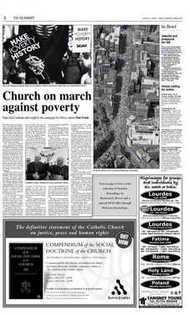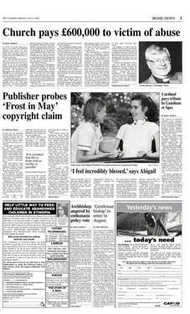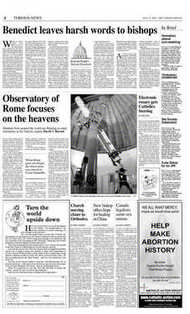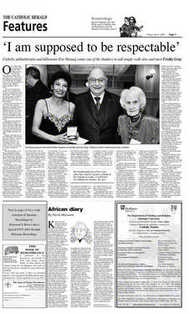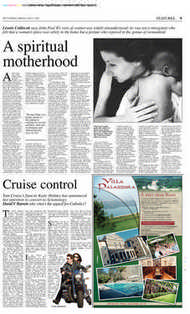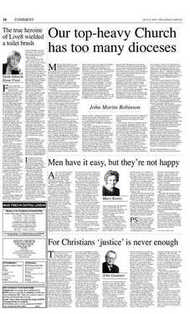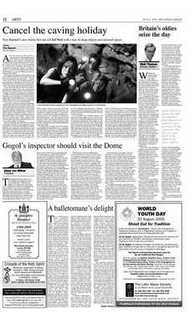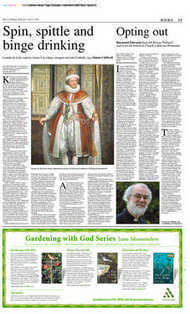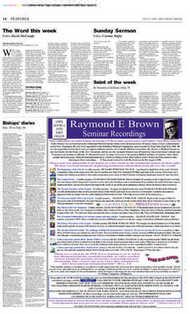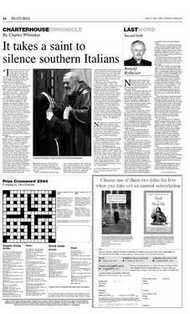Page 10, 8th July 2005
Page 10
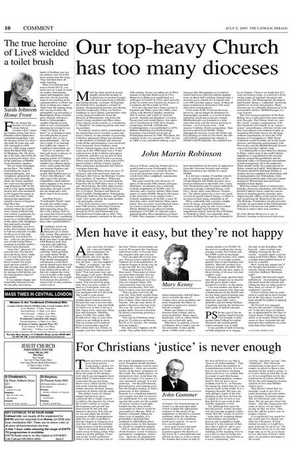
Report an error
Noticed an error on this page?If you've noticed an error in this article please click here to report it.
Tags
Share
Related articles
Catholics Asked To Debate Priesthood
Church Loses Flock In Its Northern Heartlands
Priests Increase By 50 Per Cent For Jubilee Year
Cardinal Outlines His Vision Of A 'vocations Culture'
Reversing Decline
Our top-heavy Church has too many dioceses
John Martin Robinson
Much has been heard in recent months about the decline of Catholicism in western Europe, with fewer practising Catholics and falling priestly vocations. In England the bishops have accepted a counsel of despair, amalgamating parishes and closing churches (especially if they are historic buildings or old Catholic communities with a long spiritual tradition). Even the Diocese of Westminster, which has the largest clergy numbers and Mass attendance figures in the country, is considering a “blueprint” for reducing priests and sharing parishes.
A contrary trend is rarely commented on, the remorseless move towards a more topheavy Church. As the number of practising Catholics and parish clergy has declined, so the numbers of bishops and dioceses (with all the administrative costs involved) have increased: fewer Indians, more Chiefs. Vatican figures show that in the 20 years up to the 1990s there was a 19 per cent increase in the Catholic episcopacy worldwide, and this was not just in Asia and Africa where the Church is growing. These were the decades when many European Catholics left the Church, regular Mass attendance plummeted and clerical vocations dried up.
In England and Wales there are now 23 dioceses, and with auxiliaries (and the Bishop to the Forces) the Bishops’ Conference numbers 32 members. When the Catholic hierarchy was re-established by Pope Pius IX in 1850 there were 13 bishops: Westminster, Beverley (later Leeds), Birmingham, Clifton, Hexham (Newcastle), Liverpool, Newport and Menevia (later Cardiff), Northampton, Nottingham, Plymouth, Salford, Shrewsbury and Southwark. This seems about the right number and geographic spread.
Two more dioceses were created in the later 19th century, reflecting Victorian demographic developments: Middlesbrough in 1878, and Portsmouth was detached from Southwark in 1882. This fissiparous pattern continued in the early 20th century. Essex was taken out of Westminster to become Brentwood in 1911. Menevia in Wales was established as a suffragan of Cardiff in 1916, and Lancaster in the far north-west formed out of parts of Liverpool and Newcastle in 1924.
Five new dioceses have been created in England and Wales since the 1960s, coinciding with British Catholics shrinking after a century and a half of vigorous growth. Arundel and Brighton, covering Sussex and rural south Surrey, was taken out of Southwark in 1965. East Anglia, comprising Norfolk, Suffolk and Cambridgeshire, was established in 1976; Hallam (Sheffield and North Nottinghamshire) was formed out of part of Nottingham diocese in 1980. Wrexham, the smallest of all, was created in 1987. As late as 2000 it was considered making a new diocese of Kent, reducing Southwark to a south London rump. Fortunately, this absurd suggestion was vetoed by the Vatican as the proposed small new diocese would have been completely uneconomic and unviable.
The same could be said, however, of many of the extant 20th century dioceses. Wrexham, for instance, has a notional Catholic population of 30,000, only 43 churches and a regular Sunday Mass attendance of under 10,000. Menevia (Swansea to the initiated) is even smaller with a Catholic population of 26,000, a mere 30 churches, and a small Sunday Mass attendance. Nor can many recent English dioceses claim a much larger base than the Welsh. Hallam has an official Catholic population of 67,000, 63 churches and a general Sunday Mass attendance of about 17,000. This compares with real Victorian dioceses like Westminster or Liverpool which both have official Catholic populations of about half a million (though only a minority go to church in Liverpool) and over 200 churches apiece, many of them of great architectural distinction with loyal and active congregations.
Even some of the Victorian dioceses, however, can no longer be defended on demographic grounds, as a result of postindustrial social and economic change. Middlesbrough was founded at a time when that area was the fastest-growing in Europe – an iron boom town – with massive Catholic (Irish) immigration. That proved a short-lived bubble. Today, although the diocese covers the North and East Ridings as well as Cleveland, the official Catholic population has shrunk to 88,000 with 80 churches. Its cathedral has been demolished (in the teeth of opposition from the Victorian Society) and weekly Mass attendance has shrunk to a mere 20,000.
It is not just a matter of number-crunching. It could be argued that many of the current English and Welsh dioceses are a positive hindrance to the Faith. For a start, only Westminster and Liverpool cathedrals maintain a proper cathedral liturgy, with boys’ choirs, daily sung Masses, Vespers etc. The others improvise a (not very good version of) parish church liturgy, so there is no point in their being cathedrals at all.
Many cathedrals lack a proper complement of clergy. Arundel Cathedral is currently kept going by one over-worked curate seconded from Wonersh. This magnificent church, built by the 15th Duke of Norfolk in 1868, was originally dedicated to St Philip Neri and was intended to be an Oratory. There is no doubt that if it were an Oratory today, it would be a flourishing centre of spiritual, liturgical and pastoral life, like Birmingham, Brompton and Oxford. Being a “cathedral” positively inhibits its mission and purpose. Many dioceses are so culturally disparate as to be unworkable entities. Middlesbrough is a case in point.
The rural recusant parishes of the East Riding are a world apart from post-industrial Teesside. The bishop, however, sees the “small” country congregations with their beautiful old chapels as an “uneconomic” encumbrance, oblivious of the role they have played and continue to play in sustaining the Faith. Hence his decision, without consultation, to close the 1830 basilica at Everingham in 2004. Rural Yorkshire would be better off in the Leeds diocese, and Teesside amalgamated with Newcastle, and the Middlesbrough diocese removed from the Catholic map.
It is indefensible to have three tiny dioceses in Wales, where most of the small Catholic population is concentrated in the recusant parishes around Monmouthshire and the industrial valleys of Glamorgan (descendants of Irish immigrants), all in the south-east. There should, surely, be a single diocese of Wales, centred on Cardiff. Both Menevia and Wrexham should be abolished. Hallam is another obvious candidate for dissolution, and re-amalgamation into Nottingham, while Brentwood should be split, with east London returned to Westminster and rural Essex included in East Anglia.
With less money spent on unnecessary bishops, diocesan committees and officials, limited Catholic funds could be concentrated on keeping parish churches open, improving the calibre of the parish clergy and staunching the flight from the pews. The Bishops’ Conference should seriously consider an equivalent of the Parliamentary Boundary Commission and petition the Vatican to reduce their own numbers.
Dr John Martin Robinson is one of Britain’s leading architectural historians
blog comments powered by Disqus



